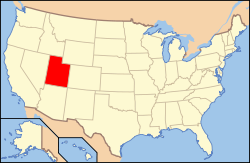
Box Elder County is a county at the northwestern corner of Utah, United States. At the 2020 census, the population was 57,666, up from the 2010 figure of 49,975. Its county seat and largest city is Brigham City. The county was named for the box elder trees that abound in the county.

Weber County is a county in the U.S. state of Utah. As of the 2020 census, the population was 262,223, making it Utah's fourth-most populous county. Its county seat and largest city is Ogden, the home of Weber State University. The county was named after a fur trapper John Weber.

Aurelius is a town in Cayuga County, New York, United States. The population was 2,610 at the 2020 census. The town was named after the Roman emperor Marcus Aurelius. It is at the western edge of the county and borders the city of Auburn.

Minersville is a town in southeastern Beaver County, Utah, United States. The population was 807 at the 2020 census, down from the 2010 figure of 907.

Brigham City is a city in Box Elder County, Utah, United States. The population was 19,650 at the 2020 census, up from the 2010 figure of 17,899. It is the county seat of Box Elder County. It lies on the western slope of the Wellsville Mountains, a branch of the Wasatch Range at the western terminus of Box Elder Canyon. It is near the former headquarters of ATK Thiokol, now Northrop Grumman, the company that created the solid rocket boosters for the Space Shuttle.

Corinne is a city in Box Elder County, Utah, United States. The population was 809 at the 2020 census, up from the 2010 figure of 685.

Fielding is a town in Box Elder County, Utah, United States. The population was 455 at the 2010 census.

Howell is a town located in the Blue Creek Valley in northeast Box Elder County, Utah, United States. The population was 245 at the 2010 census.

Mantua is a town on the eastern edge of Box Elder County, Utah, United States. The population of the town was 1,090 at the 2020 census.

Perry is a city in Box Elder County, Utah, United States. The population was 4,512 at the 2010 census.

Riverside is a census-designated place (CDP) in Box Elder County, Utah, United States. The population was 760 at the 2010 census.

Snowville is a town in Box Elder County, Utah, United States. The population was 167 at the 2010 census.

South Willard is a census-designated place (CDP) in Box Elder County, Utah, United States. The population was 1,571 at the 2010 census.

Meadow is a town in Millard County, Utah, United States. The population was 254 at the 2000 census. Originally called Meadow Creek, the town is located about eight miles south of Fillmore.

Moroni is a city in Sanpete County, Utah, United States. The population was 1,423 at the 2010 census.

Coalville is a city in and the county seat of Summit County, Utah, United States. It is part of the Salt Lake City, Utah Metropolitan Statistical Area. The population was 1,486 as of the 2020 census. Interstate 80 passes through the town, as well as the Weber River, which flows into Echo Reservoir, just north of Coalville.

Charleston is a town in Wasatch County, Utah, United States. The population was 436 at the 2020 census.

Washington is a city in south central Washington County, Utah, United States and is a part of the St. George Metropolitan Area. The area is also known as Utah's Dixie because the Mormon pioneers who settled the St. George area came to the area to raise cotton, which was milled at the cotton mill in Washington. The population was 27,993 as of 2020. Washington is a fast-growing suburb of St. George, and is the second largest city in Washington County.

Farr West is a city on the northern edge of Weber County, Utah. The population was 7,691 at the 2020 census, up from 5,928 at the 2010 census. It is part of the Ogden–Clearfield metropolitan area. As of 2022, the mayor is Ken Phippen.

Marriott-Slaterville is a city in Weber County, Utah, United States. The population was 1,701 at the 2010 census. It is part of the Ogden–Clearfield, Utah Metropolitan Statistical Area. The city was incorporated in July 1999, in a merger of the previously unincorporated communities of Marriott and Slaterville.























